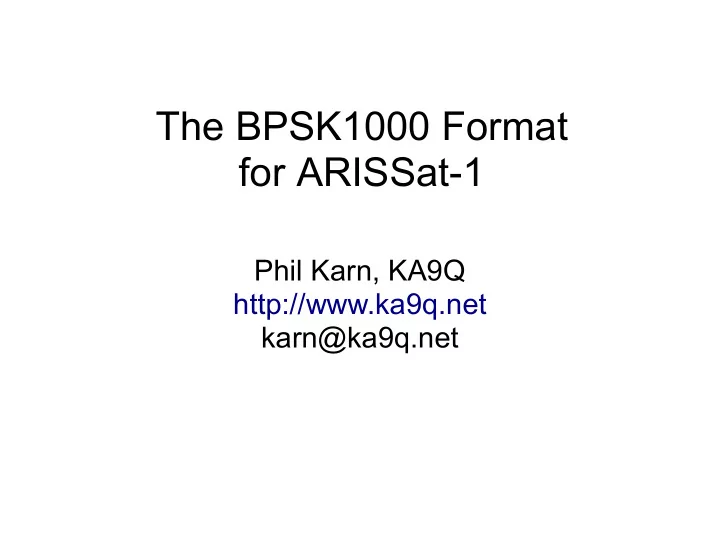

The BPSK1000 Format for ARISSat-1 Phil Karn, KA9Q http://www.ka9q.net karn@ka9q.net
BPSK1000 ● Framing, coding & modulation designed for ARISSat-1 telemetry downlink ● Fits in SSB bandwidth, CW beacon as pilot ● Optimized for severe fading → 16 sec delay ● 500 b/s user rate, variable size frame ● rate ½ FEC, Viterbi decoding → 1 kbaud ● DBPSK, α = 1.0 → BW = 2 kHz ● E b /N 0 ≥ 6.7 dB on AWGN channel
ARISSat Requirements No special receiving equipment ● Just a generic SSB receiver & computer ● Efficient use of spacecraft power ● Tolerate deep, slow fading ● Easy manual Doppler tuning ● Do not assume satellite experience ● Automatic tracking nice but not required ● Simple generation by IHU and SDX
BPSK1000 Summary ● HDLC framing with 32-bit CRC ● R=1/2, k=7 convolutional FEC with Viterbi decoding ● 128-way convolutional interleaving with bit- reversed delay line ordering ● Differentially coherent binary phase shift keying ● Noncoherent detection (implementation choice)
BPSK1000 Encoding Data frames in CRC-32 HDLC encoder FEC encode, r=1/2 k=7 Ye olde Voyager code 128:1 Convolutional interleaver Bit-reversed delay ordering 1 → no change Differential encode 0 → 180° change BPSK modulator RF out
HDLC Frame Format
HDLC with CRC-32 ● HDLC with 16-bit CRC part of AX.25 Layer 2 ● Basis of amateur packet radio since 1982 ● Variable length frames ● CRC-32 essentially eliminates spurious frames ● allows Viterbi decoding without Reed-Solomon
Convolutional FEC ● Rate ½ k=7 with Viterbi decoding ● Same as in AO-40 FEC ● Like all convolutional codes, requires interleaving to tolerate burst errors ● Very fast vectorized software decoders ● 20-40 Mb/s on reasonably modern PCs
Convolutional encoder
Convolutional Interleaving ● Not to be confused with convolutional coding ● Vs block interleaving on AO-40FEC ● Operates on a continuous bit stream ● De-interleaver priming required ● Half the delay and memory for given depth ● Usual rule: maximum fade < 10% of depth ● BPSK1000 uses 128:1; 128 2 =16,384 ● Delay of 16.384 sec at 1 kbaud
Convolutional Interleaver 4 Sample 4:1 interleaver Delays: 0, 1, 2, 3
Convolutional De-interleaver Delays: 3, 2, 1, 0 Sum of sender & receiver delay on each row is constant
Bit-reversed ordering ● The delay elements can be in any order ● As long as sum of delays constant for each row ● Bit-reversed ordering seems to improve distance properties ● 000 001 010 011 100 101 110 111 → ● 000 100 010 110 001 110 011 111 ● i.e., 0, 1, 2, 3, 4, 5, 6, 7 → ● 0, 4, 2, 6, 1, 5, 3, 7
Demodulating BPSK1000 Rx audio in Brute force during Estimate carrier freq & symbol timing acquisition, then track Demodulate DBPSK De-interleave Viterbi decode 128 copies during acquisition, 1 for each interleaver HDLC decode phase Decoded frames
Demodulating DBPSK ● No carrier phase tracking needed! ● Impossible on fading channels ● Still need: ● symbol timing ● approx carrier frequency
Dot Product Detection Q S n I Detected symbol = S n •S n-1 S n--1 Dot product |S n | |S n-1 | cos θ ∴ I n-1 I n + Q n-1 Q n symbol '1' → no change → + dot product Symbol '0' → 180° change → - dot product No phase locking, so phase is arbitrary Frequency error appears as slow rotation
Frequency errors in DBPSK ● Frequency errors cause slow rotation of signal phasor. ● Effective signal loss in dB = 20 log 10 cos(2 π E/R) ● E = frequency error, R = baud rate ● e.g., 50 Hz error @ 1 kbaud → 0.44 dB loss ● 100 Hz error @ 1 kbaud → 1.84 dB loss
Nonfading channel performance Differ Demod FEC Eb/No Fade ential 10 -5 BER tolerance encod ing Yes non-coherent None 10.3 Good No coherent None 9.6 Bad Yes non-coherent r=1/2, k=7 6.7 Good Yes coherent r=1/2, k=7 5.9 Bad No coherent r=1/2, k=7 4.4 Bad No coherent R=1/2 k=7, (255,223)RS 2.5 Bad No coherent R=1/6 turbo, 8920 bit blk -0.1 Bad
ARISSat-1 vs AO-40 ● Slow Doppler ● Faster Doppler ● Weaker signal ● Stronger average signal ● Periodic spin fading ● Random fading ● Fixed frame size ● Variable data frames ● Hardware restrictions: ● IHU/SDX software 400 baud, BPSK, Biphase
AO40/ARISSat comparison AO40FEC ARISSat Baud rate 400 1000 Data rate 160 500 Error control r=1/2, k=7 convolutional r=1/2, k=7 convolutional (160,128) Reed-Solomon CRC-32 Overall rate = 0.4 Overall rate =~ 0.5 Baseband Biphase NRZI Interleaving Block, 5200 symbols 128:1 convolutional Interleaver depth 13 sec 16.384 sec Sync vector Yes No Block size 256 bytes variable Differential coding Yes Yes Modulation BPSK BPSK Scrambling Yes No
Future Formats ● AMSAT needs a family of modulation & coding schemes ● HEO, LEO, telem, comms, freq, BW, speed... ● There's no one-size-fits-all! ● Broadcast vs Interactive ● Broadcast – long interleavers ● Interactive – short interleavers, hybrid ARQ ● Uplink is a different, unaddressed problem ● multiple access ● greater power
Recommend
More recommend